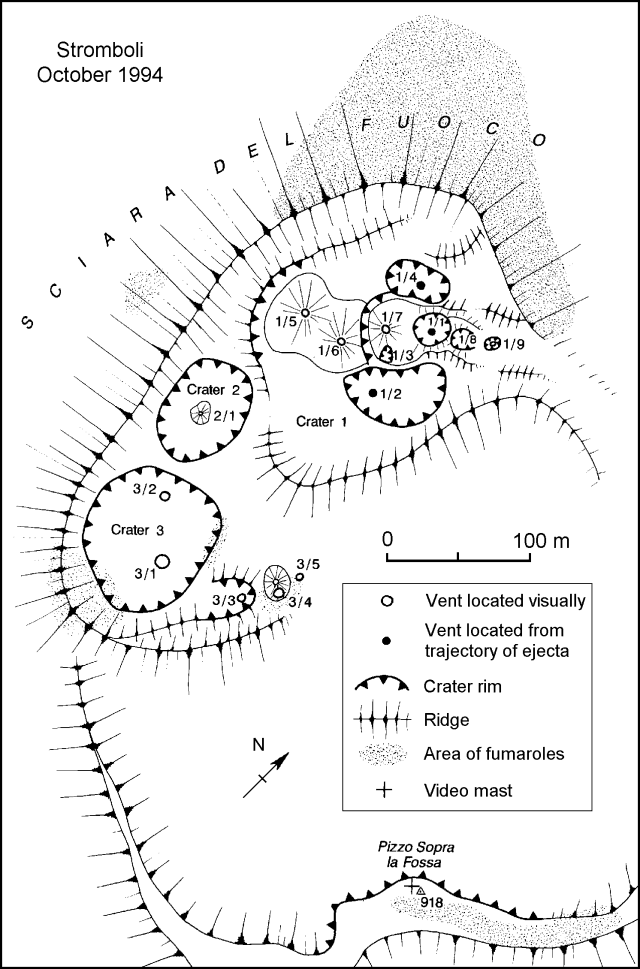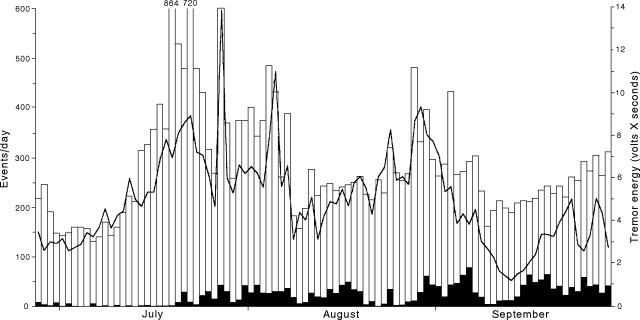Report on Stromboli (Italy) — October 1994
Bulletin of the Global Volcanism Network, vol. 19, no. 10 (October 1994)
Managing Editor: Richard Wunderman.
Stromboli (Italy) High seismicity during July-September; eruptive activity described
Please cite this report as:
Global Volcanism Program, 1994. Report on Stromboli (Italy) (Wunderman, R., ed.). Bulletin of the Global Volcanism Network, 19:10. Smithsonian Institution. https://doi.org/10.5479/si.GVP.BGVN199410-211040
Stromboli
Italy
38.789°N, 15.213°E; summit elev. 924 m
All times are local (unless otherwise noted)
Following the slow decrease of tremor energy during June, all seismicity increased in July (figure 36). Tremor energy reached an unusually high peak on 27 July; at the same time, a peak in the number of events was recorded. Although more events were recorded on 19 July (864), that was a period of almost continuous explosive activity. A considerable number of saturating events were recorded after 20 July. Volcano guides observed very strong external activity, with pyroclastic material often reaching the usual tourist zones. A decline in tremor energy was observed after 10 August; a slow increase then followed, reaching a new maximum at the end of the month. The number of recorded events followed a similar trend. Another major decrease in tremor energy characterized the first half of September; later fluctuations remained in a "low-energy" range. Vigorous eruptions seen on 21-22 August occurred during a period of low seismicity compared to late July and late August.
Observations of crater activity were made by R. Carniel (Univ of Udine) during field work with R. Schick (Univ of Stuttgart) and collaborators at the end of September and early October. Similar observations were made by geologists from Open Univ during 1-13 October, with detailed explosion counts for 3 hours on 1 October, 4 hours on the 5th, and one hour on the 9th. Explosions sent incandescent ejecta, ash, and/or gas to heights of <=300 m, from as many as 10 active vents (figure 37). No active vents were observed in Crater 2, but a hornito (2/1) was visible, and there was minor degassing from an unknown source. Brightness temperatures of fumaroles along the zone E of the Pizzo Sopra la Fossa (39-77°C) were measured by Open Univ geologists with a Minolta/Land Cyclops Compac 3 hand-held radiometer (8-14 mm).
 |
Figure 37. Sketch map of the active craters at Stromboli, 1-13 October 1994. Courtesy of A. Harris [and A. Maciejewski]. |
Within Crater 1 in late September, Carniel noted three cones ~25 m high that had been built during the very strong activity in July and August (1/5, 1/6, & 1/7; figure 37). Continuous red glow at night could be seen from the top of each. Two other Crater 1 vents were active, the first (1/4) producing short, lateral explosions with large pyroclasts ejected onto the Sciara del Fuoco, and the second closer to Pizzo producing longer and higher explosions (<=200 m). Directed explosions suggested the possibility of a third vent close to the second one. When one of the two W-most cones in Crater 1 erupted (typically with strong degassing and little pyroclastic material) the other exhibited weak degassing. When the second vent erupted, the red glow from the remaining cone strengthened, sometimes with minor degassing.
Crater 1 contained six active vents during visits by Open Univ scientists. Explosions from vents 1/1 (~2/hour), 1/2 (4-9/hour), and 1/3 (0-2/hour) sent incandescent ejecta, occasionally with ash, to heights of 30-250 m. Glow was seen above 1/1 and 1/2 on the night of 5 October. Up to 40% of the ejecta from 1/2 and 1/3 fell outside of the crater area. These explosions were often followed by a gradually fading gas-jet noise of variable length. Explosions seen by the Open Univ team from 1/4 (2/hour) sent incandescent ejecta, including bombs and spatter, 30-150 m E onto the Sciara del Fuoco. On 5 October hornito 1/5 was the source of gas-jet eruptions, and a small amount of incandescent ejecta rose ~50 m; during 10 October more ejecta were seen in 100-m-high gas jets. Hornito 1/7 constantly degassed, and its summit vent was incandescent with a continuous gas flare 1-2 m high. On 10 October this flare increased 1-2 seconds before vent 1/3 erupted. Hornito 1/6 and vents 1/8 and 1/9 vents were only degassing.
The lava pond in Crater 3 had become a small spatter cone (3/2) when observed by Carniel, with a hole through which magma could be seen; activity was limited to degassing. One vent produced high, black, mushroom-shaped columns, and the second (in front towards Pizzo) sent pyroclasts >200 m above the craters. The opening of a new vent was also observed. Explosions from Crater 3 on 28 September were stronger, although less frequent, than from Crater 1. On 5 October the same sequence was observed, with the second vent exploding first and fewer pyroclasts ejected near the end of the explosion by a very small vent to the right of the older one. Guides reported that this vent was first observed on 1 October, when similar explosions from the small vent ejected spatter.
Open Univ geologists noted that only vent 3/2 was active on 1 October, with 3 emissions/hour of brown ash and blocks. By 5 October the quantity of ash emitted had decreased, but the amount of incandescent ejecta had increased, and more frequent explosions (5/hour) were accompanied by loud detonations. Ejecta rose 80-300 m, with some material landing outside of the crater or on the inner crater wall. During night observations on 5 October vent 3/2 would start erupting ~1-3 seconds after 3/1. On 8 October, Crater 3 released gas, sometimes accompanied by minor amounts of ejecta <30 m above the crater rim, and small brown ash clouds 30-100 m high. Similar activity on 9 October was accompanied by an increasing amount of brown ash and incandescent ejecta. During 1 October small lava fountains from vents 3/3 and 3/4 were simultaneous with gas emissions from 3/3. Vent 3/4 was also continuously active with puffs of gas (~1/second). The interior of vent 3/4 was incandescent by day, and glow was observed above 3/1, 3/2, and 3/3 at night. During the night of 5 October the brightness temperature of 3/4 was measured as 873°C, using a Minolta/Land Cyclops 152 hand-held radiometer (0.7-1.1 mm), similar to October 1988 (13:11). Incandescent gas puffs were seen above 3/4 during the night of 10 October. Only minor gas emission was observed from vent 3/5.
Geological Summary. Spectacular incandescent nighttime explosions at Stromboli have long attracted visitors to the "Lighthouse of the Mediterranean" in the NE Aeolian Islands. This volcano has lent its name to the frequent mild explosive activity that has characterized its eruptions throughout much of historical time. The small island is the emergent summit of a volcano that grew in two main eruptive cycles, the last of which formed the western portion of the island. The Neostromboli eruptive period took place between about 13,000 and 5,000 years ago. The active summit vents are located at the head of the Sciara del Fuoco, a prominent scarp that formed about 5,000 years ago due to a series of slope failures which extends to below sea level. The modern volcano has been constructed within this scarp, which funnels pyroclastic ejecta and lava flows to the NW. Essentially continuous mild Strombolian explosions, sometimes accompanied by lava flows, have been recorded for more than a millennium.
Information Contacts: R. Carniel, Univ di Udine; A. Harris and A. Maciejewski, Open Univ.


